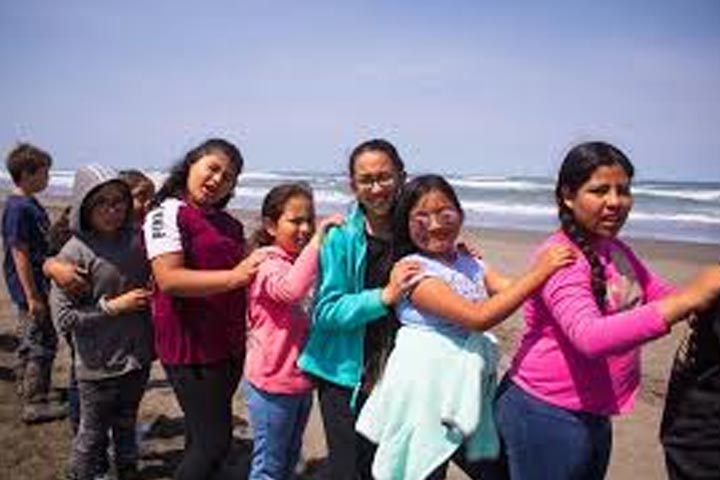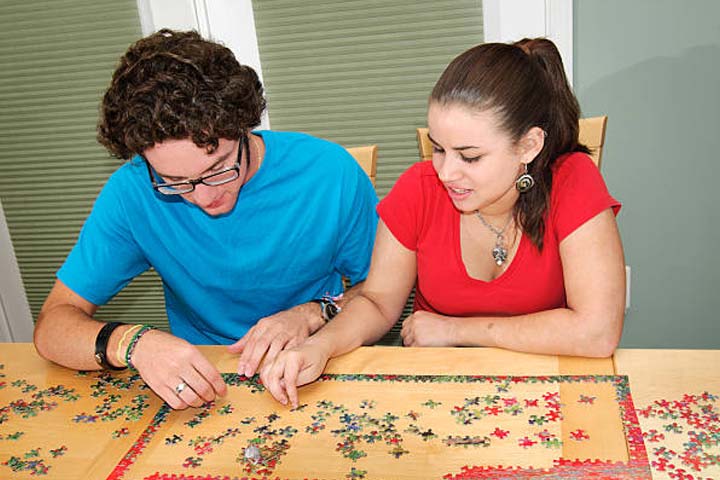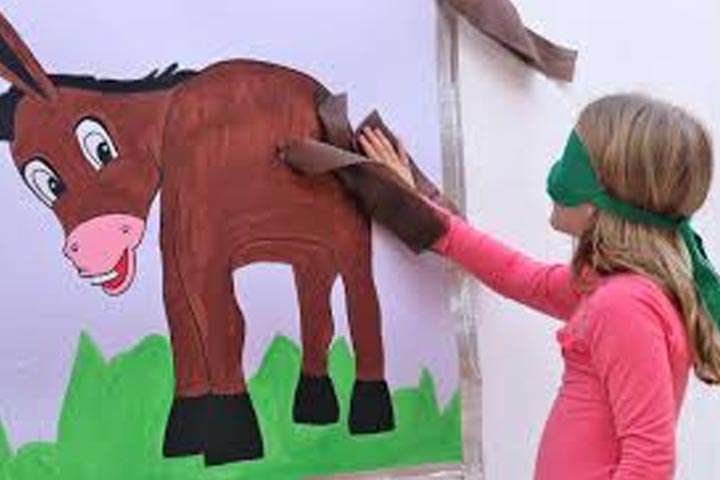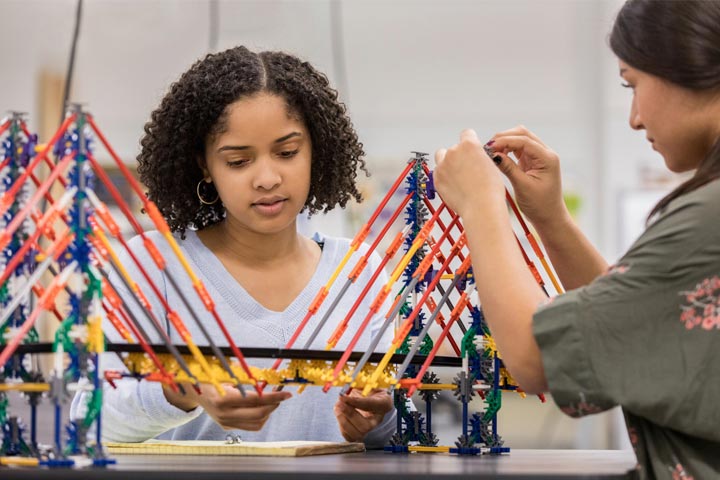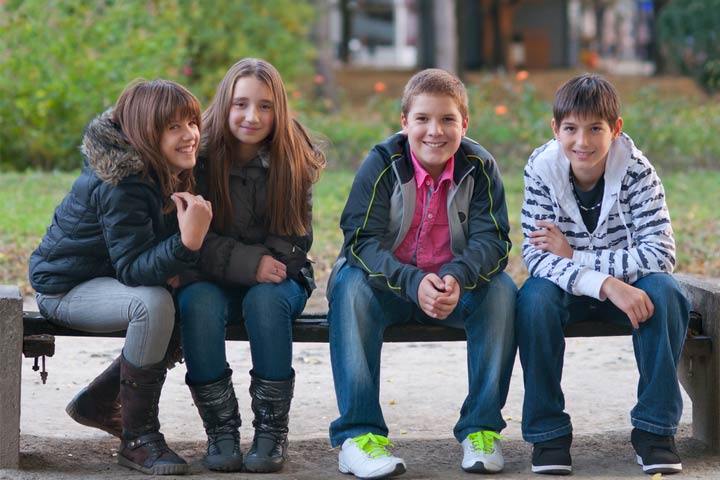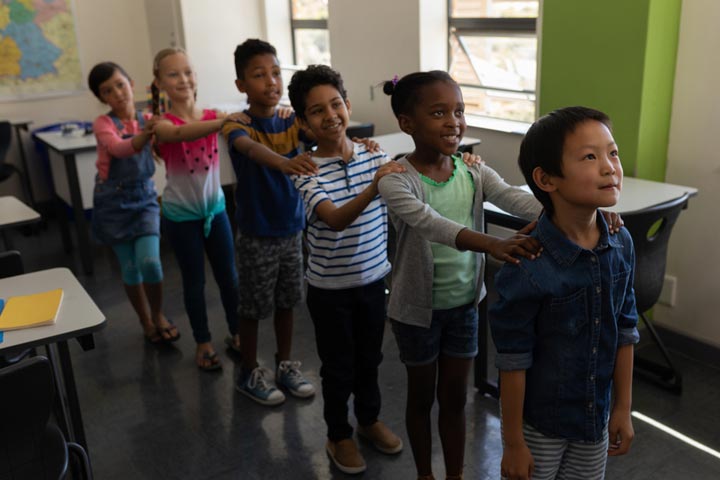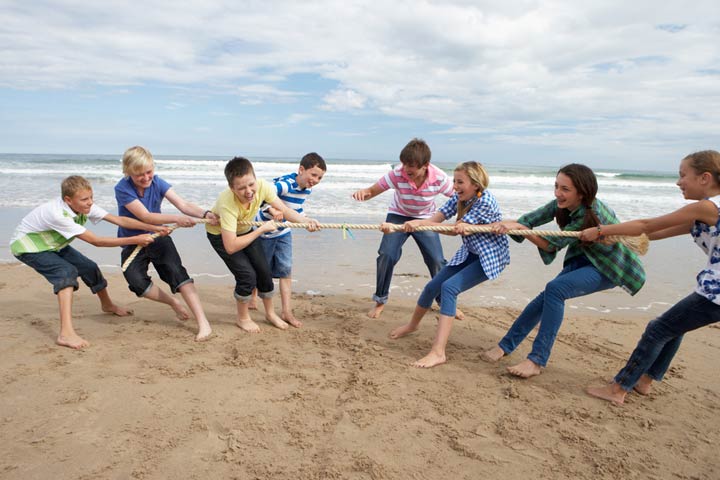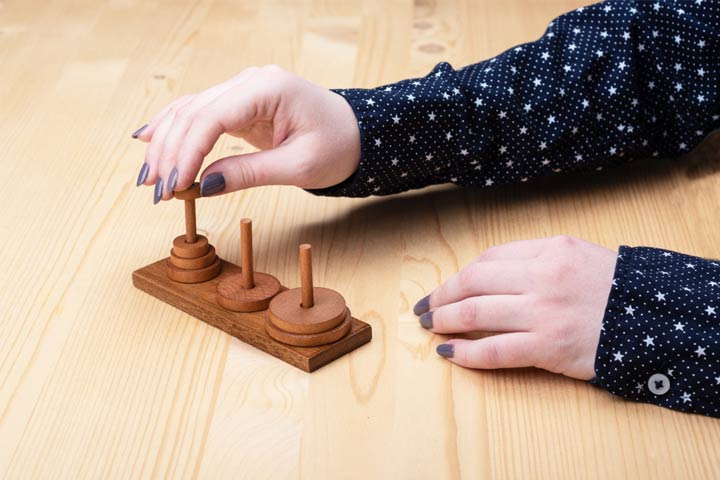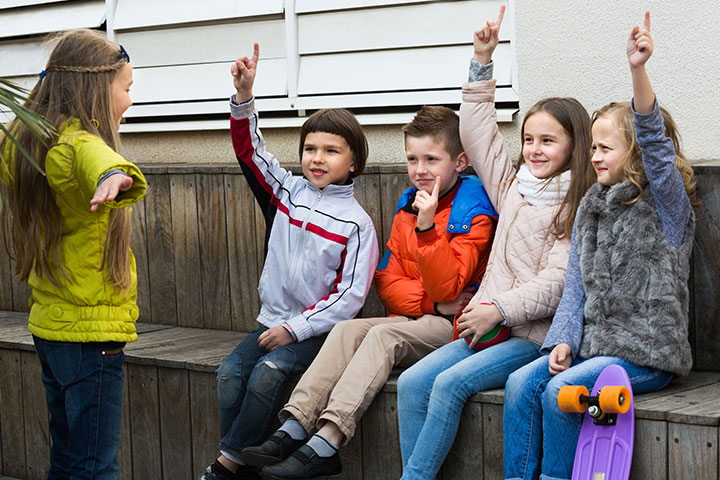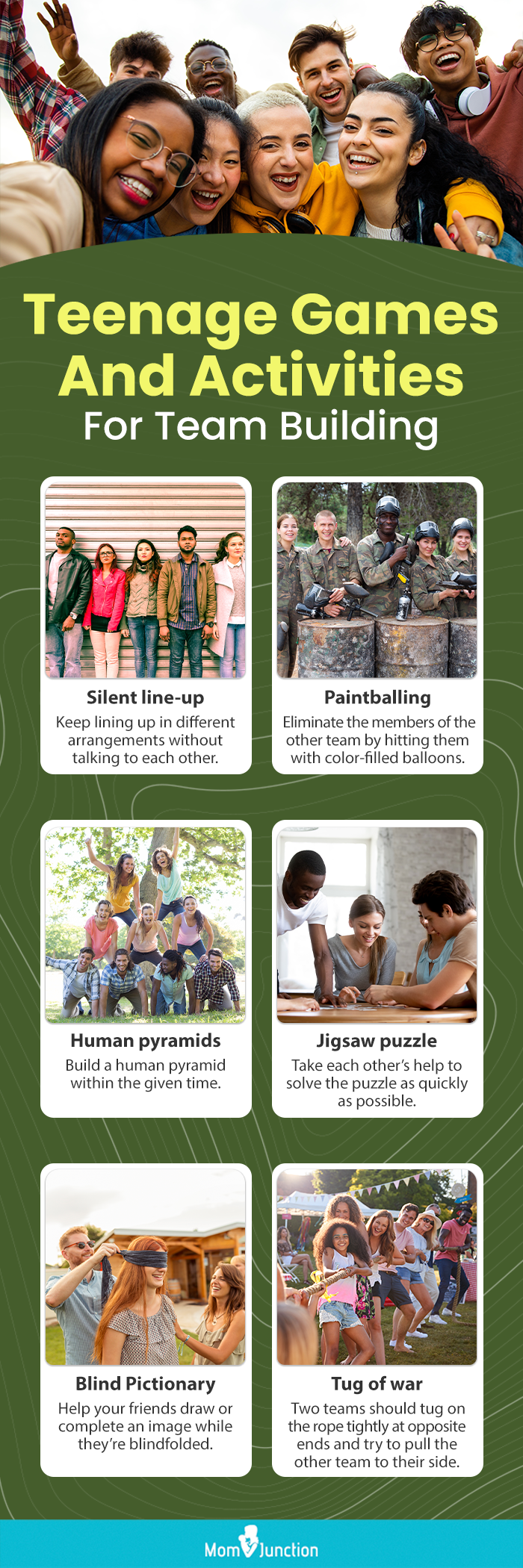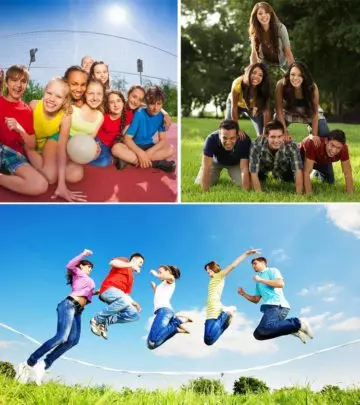
Image: iStock
While some teenagers can get along with their peers or a group, others might struggle to work together in a team. Teen team building activities are a great way to teach your wards the art of teamwork and instill leadership skills in them. There are certain interesting games and activities that can come to your rescue and help teens build interpersonal skills to survive in a group. In this post, we share with you some team-building activities that help teens become team players and build self-awareness and trust. Scroll down.
Benefits of Team Building Activities
Here are some positive aspects of team building activities for teens (1) (2)
- Build relationships: As your teen gets involved in a team-building activity, they learn to interact with different people. This interaction exposes them to the concept of individual perspectives, which is an important part of social skills.
- Sharpen communication skills: Some teenagers are introverted and struggle to communicate. Team building activities and games can provide them with a good opportunity to learn to mingle.
- Motivate: Research shows that teenagers can be immensely encouraged by their peers. Therefore, team building games or activities with their friends or classmates are an opportunity for children to get motivated to work on a given task.
- Promote productivity: Working in a team means coming up with multiple ideas and collating them to address the problem in hand. This pattern of working helps teens identify their strengths and weaknesses, which can be used to enhance efficiency and productivity.
- Develop critical thinking: In the process of contributing individually to the activity, teens learn about various ways to face a situation. This broadens their logic and problem-solving skills that are necessary to achieve a goal.
- Enhances Co-operation: Team building activities teach your teenager cooperation with different sets of people in order to achieve a common goal.
- Enables feedback: It provides the opportunity for teenagers to receive feedback and to utilize them constructively.
- Develops leadership skills: These activities encourage a sense of agency and responsibility and can help the teenager to acquire and develop their leadership qualities and skills.
Team Building Activities And Games For Teens
These are a mix of several team-building games and activities that deal with various areas of development, such as problem-solving, decision-making, adaptability, planning, and trust-building.
1. Boo the dragon
- Divide teens into teams of six to seven members each. One teen plays the dragon and thus becomes the judge.
- In the game, teens live in a village that is under the dragon attack, and they need to scare away the dragon. Each team represents a village.
- The villagers need to arrange themselves in order of tallest to shortest while they are blindfolded.
- They can discuss among themselves and try ways to stand in a line in increasing order of their heights as fast as possible.
- Once the task is completed, the villagers have to say “Boo!” to scare away the dragon. The team who finishes the task and is first to say “Boo!” to the dragon wins the game.
2. Silent line-up
- The participants have to stand in a line, with respect to certain characteristics. For instance, you can ask all the teens to stand as per their shoe size.
- So, the participant with the smallest shoe size will be first in line, whereas, the one with the highest will stand last.
- The twist here is that they have to arrange themselves in a particular order without talking to each other.
3. Electric fence
- This game is all about trust and good teamwork, where all the members have to think smart.
- Make teams with four to five members each.
- Tie a rope at a height from the ground. It represents the electric fence.
- Now assign a time limit, say 30 seconds, within which each team has to jump over the rope and cross the ‘electric fence’ safely without stepping on the rope.
- You can let one team perform at a time and then see which team has finished the task faster.
4. Collab to create
- Choose a final product/project with several elements that you want the team to work on. For instance, you can ask the team to develop a storybook for toddlers, wherein, each teen will have to write a part of the story.
- Working towards a common task/goal with individual components will enhance their collaboration skills. The teens will also learn the importance of productive communication.
5. Unknot
- Ask all the teens to stand in a circle, stretch their arms, and close their eyes.
- Once they do that, ask them to hold the nearest hands without looking at whose hand they hold.
- Since the hands would have tangled, the challenge then would be to detangle the human knot without letting go of the hand they held.
- Teens will have to work together to go over and under one another in a weave pattern.
- This game helps enhance faster and accurate decision making through effective communication. It is one of the best examples of games and activities that enhance interpersonal communication.
Ester Lee, the STEM teacher and blogger, speaks about playing ‘Unknot’ in her class. She says, ”The kids loved this exercise. We would pull it out every few weeks. When we first started, there was no end to the confusion and lack of coordination on the kid’s part. But by the end of the season, they figured out how to appoint a ‘director’ to tell them how to undo the knot and they were able to untie the knot (i).”
6. Paintballing
- This active team activity needs physical strength. Paintballing may seem a bit too rough for some teens. However, it can be fun too.
- To play the game, you need two teams. Each team will be given a certain number of balloons filled with colors. The task is that each team has to throw these balloons on the opposite team and try to paint each member. The member who gets hit by the colored balloon and has color over him/her will be eliminated.
- This way, one team has to eliminate the maximum number of players from the other team.
- Each team member learns to work together, defend themselves, and protect one another by planning strategically as a team.
7. Photo finish
- Draw a straight line on the ground and ask all the players to stand on one side of the line.
- Then, when you say go, they have to cross the line at the same time.
- It sounds easy, but it is not. It takes a few tries and some creative problem solving to know how they can all cross the line at the exact time.
- This game can be more fun if you click pictures or take videos of the activity.
8. The egg drop
- Provide the players with plenty of household materials and a carton of fresh eggs.
- They should use the provided household material to create a container in which they will drop the egg.
- The goal here is that the dropped egg must not break.
- The activity can be made challenging by asking the player to stand on some height, like on a chair before dropping the egg.
- It is a good instance to teach your teen the value of thinking out of the box.
9. The future antique
- Begin the game by dividing the players into a few teams.
- Ask each team to pick an item from a pile of random household materials like broken mugs, pipe cleaners, cardboard boxes, a broken watch, etc., and make up a story about the item being found as an “antique” 500 years in the future. This whole process should be completed in five minutes.
- The challenge here teaches your teen to work collaboratively. This needs quick and accurate communication among teens, which is effectively coordinated by a leader.
10. Draw back-to-back
- Begin this great activity by randomly arranging the teens in pairs with each pair representing a team. Each team member sits back-to-back with their partners, that is, they sit facing away from each other.
- One teen will receive a blank piece of paper with a pen or a marker. The other will receive a piece of paper with a shape or simple drawing on it.
- The teen who receives the illustration should verbally describe the drawing to the other teen without looking at him/her. The other teen is supposed to draw the illustration by listening to the verbal instructions alone.
- The team who completes the task first wins the game.
11. The baggy skit
- It is a fun-filled activity that often brings a great laugh. Besides, it also provides a great opportunity for teens to identify the strengths and weaknesses of each team member and utilize it for the team’s benefit.
- Start the game by dividing the teens into teams of four or five participants each.
- Give a bag containing three to four household items to each team.
- Each team now has to perform a skit using the items as props. The team that uses the items most effectively wins the game.
- Recording the skit that each team performs will be a good idea as the teens can watch it and cherish the memories.
12. Creeping closer
- This activity can teach the teen to be observant and to develop healthy competition skills.
- Divide the teens into teams; each team has to select a teen as the “captain.”
- The captain has to stand on one side of the play area, facing the wall/fence. The remaining participants stand on one leg at the opposite end of the fence/wall.
- The objective of the game is to reach the captain.
- When the captain shouts, “Start,” the participants slowly start hopping towards the captain in complete silence.
- If the captain turns around, the players have to freeze. Once the captain turns around, the team continues to hop to reach the captain.
- If the captain sees anyone move from their place or anyone falls, then the entire team will have to return to their start position.
13. Human pyramids
- It is an active outdoor activity that demands teamwork and physical strength. This activity can foster bonding among team members through teamwork, fine leadership skills, and effective communication.
- Start the game by dividing teens into teams of four or five members each.
- Then, each team forms a human pyramid within a stipulated time, say five minutes.
- To do this, three team members kneel down on all fours, and then the next three climb on their backs and make another layer. In the pyramid, team members should stand in a circle facing inwards.
 Quick fact
Quick fact14. Treasure hunt
- This is a fun-filled activity that teens will love for all the giggles and laughter it brings.
- In the game, divide the teens into teams of four to five members each.
- Ask each team to stand in a straight line with all facing in one direction. Each teen places their hands on the shoulder of the teen in front of them to form a line.
- The teen who stands at the front of the line is blindfolded.
- Spread different items across the room or field.
- Each team has to collect these items while maintaining the line. The non-blindfolded team members guide the blindfolded front-ender through instructions, such as “move right,” “take three steps forward,” and so on.
- The team that collects all items in the least amount of time wins the game.
15. Jigsaw puzzle
- Take a jigsaw puzzle and divide it into small sections.
- Provide these sections of the puzzle to different sub-teams within a team.
- Each sub-team has to complete the puzzle as quickly as possible.
- One done, all the sub-teams work together to complete the large puzzle that is the entire picture.
- This activity helps enhance the problem-solving skills of teens. It also helps in the development of cooperation and teamwork, which is necessary to achieve bigger goals.
 Did you know?
Did you know?16. Blanket volleyball
- This game is a perfect example of teamwork and coordination.
- In this game, you need to divide the teens into two teams.
- Hand over a large sheet or blanket to both teams.
- The task is that each team has to throw the ball over the net to the opposite team, who has to catch the ball using the blanket or the sheet.
- The team that has maximum catches is the winner.
17. Blind Pictionary
- This is a simple yet fun-filled team building activity that makes a teen learn teamwork by analyzing and utilizing the team strength.
- To start the activity, divide the teens into two teams. Now, each team will take turns to draw an image on the board.
- The twist here is that the team member who draws will be blindfolded. So as he/she draws the image whispered to by the judge, his/her teammates have to identify that image.
- The team that guesses the maximum number of images will be the winner. You can also set a time limit to make the game challenging.
18. Build a bridge
- Each team has to strategically utilize the given resources to complete the primary objective within the set time limit.
- Divide the group of teens into two teams. Assign a bowl of water and a building kit with items like pop sticks, putty, string, paper clips, etc., to each team.
- Set the timer for 20 minutes and ask the team to prepare a bridge that runs over the water bowl.
- Once the time is up, each team will demonstrate the strength of their bridge by placing pebbles on it. The bridge that falls first loses the game, and the winning team gets a prize!
19. Spot the difference
- Divide the players into two teams.
- Ask the first team to stand in a line facing the second group.
- The second team has a set time (say, five minutes) to look at the other team’s appearance.
- Once their time is up, the second team will leave the room, and the first team will change ten things about them.
- The ten things must be noticeable. When the second team returns, they must observe the first team again and identify the ten things that changed.
- Each correct guess or identification grants a point, and the team with maximum points wins.
20. Looped to rope
- Divide the teens into two groups. Each group should have a minimum of five members.
- To play, make a big circle out of rope for each team and put it on the floor.
- Each team has to stand at the edges of the circle, so the rope is taut around their ankles while holding their hands in the air.
- Team members must take turns moving to work the rope up from ankles to wrists, keeping hands in the air at all times. The team member will have to wiggle and move to slide the rope up. Other team members can help by keeping the rope as taut as possible.
- The team that finishes the challenge first, wins!
- This fun activity helps enhance communication and problem-solving skills.
21. Lap sit
- This game suits a group of more than ten players.
- Ask the teens to stand in a circle, facing counter-clockwise.
- Instruct the players to put their left leg inwards towards the circle and move in and shrink the size of the circle.
- The players keep moving closer until each player is touching the other player’s side.
- On a count of three, the players put their hands on the shoulders of the player in front of them.
- Then tell them to sit down slowly. If the teams do it correctly, then they will end up sitting in each other’s lap.
- Engaging in this team-building activity could enhance socialization skills and promote effective communication.
22. Dog, rice, and chicken
- Divide the players into teams. One member from each team will be asked to play the role of a farmer while other team members will act as villagers.
- The farmer has to return home along with his/her purchases, i.e., dog, rice, and chicken, by crossing a river in a boat.
- The challenge, however, is that the farmer can carry only one item on the boat. But the farmer has to ensure that chicken does not eat the rice, and the dog does not eat the chicken.
- So, how does he/she get all three purchases safely? The villagers can help him/her in finding a solution.
- The team that completes the task first wins.
- This game is a perfect brain teaser for teens to think creatively.
23. Tug-of-war
- Divide the teens into two teams. Each team will stand facing one another while holding the end of a rope.
- Instruct the teens to hold the rope tightly. Once the teams are ready, the group moderator will blow the whistle.
- The teams start pulling the ropes with all the strategy and strength to bring down the opposing team.
- The team that gets the opposite team pulled beyond the central line wins the game.
 Trivia
Trivia24. Tower of Hanoi
- You will need a puzzle toy with three towers or pegs. One tower, at the extreme end, will consist of several discs arranged in a way with the largest at the bottom and the smallest on top.
- The goal is to move the entire stack of discs from the tower at one end to the tower at the other end.
- The team can use the middle tower to temporarily place the pegs while moving pegs to the other end. However, the rules are that only one disc can be moved at a time, and you cannot place large-sized discs on smaller discs.
- You can time the game. The team that gets all the discs from one tower to another wins the game.
- The game involves mathematical and logical twists that provide ample opportunities for discussion, problem-solving, and planning.
25. The consensus exercise
- Divide the players into four or more teams, depending on the strength of the participants.
- At the mediator’s signal, each team has to nestle closely and come up with a sound and action to perform for the other teams.
- Each team performs twice for other teams.
- The goal for all the teams is to make the same sound and do the same action at the same time.
- The game will continue until all the groups perform the same sound and movements in synchrony.
26. Pass the hula hoop
- Make the players stand in line with one kid holding the hula-hoop over his/her arm.
- Tell the players to join the hands and try doing the shuffle, shove, and shimmy together.
- They have to shuffle the hula-hoops over their shoulders, arms, and legs to pass it to the partner next to him/her.
- The goal is to complete the passing of the loop without breaking the chain.
- Any player who drops the loop will be sent out to the team.
- The team that passes the hula-hoop from one end to another in the shortest time wins the game.
27. Helium stick
- Divide the players into two teams and let them stand in a line shoulder to shoulder. Each member extends their hands forward with their palms facing upwards. They fold their fingers to point only their index finger forward.
- Place a long rod in such a way that it rests on each player’s finger.
- On the count of three, the teammates have to place the rod on the ground or floor without dropping it.
- The team that completes the challenge first or in the shortest amount of time wins the game.
28. Animal farm
Image: Shutterstock
- Write different animal names on slips of paper. You may choose to write domestic or wild animals, birds, or any category of animals.
- Divide teens into groups with equal members.
- Each participant picks a piece of paper and acts out the animal without speaking. They may make sounds or behave like that animal.
- The other teammates should guess the animal. Each correct guess earns a point.
- If you want to have a variation and make the game more challenging, you may set a time limit for each round.
How To Keep Teams Engaged During The Team Building Activity
You may use these tips to make teens participate and keep them engaged.
- Choose games with goals and challenges that are easy to understand and achieve.
- You can make the goal difficult, but ensure it is attainable. A goal that seems impossible can demotivate the teens and lead to a lack of active participation.
- Clearly communicate the benefits of the activity that you have planned. Set a reward system so that an environment of competition and enthusiasm is created.
- Make the activity attractive and challenging. For instance, a simple run could be made challenging by setting obstacles on the race track.
- As a trainer/mediator/facilitator, create an environment of cooperation and trust.
- Guide and encourage them during the activity and try to keep their morale high.
- Clearly communicate the rules and safety aspects of the activity.
- Even when you have made arrangements for participant safety, be vigilant during the game/activity. Set proper penalties for flouting boundaries and safety rules.
Frequently Asked Questions
1. Are there any virtual team-building activities for teens?
Some virtual team-building games for teens include Virtual Team-Building Bingo, Virtual Book Club, Virtual Scavenger hunt, and Virtual Trivia.
2. What are some tips for organizing effective team-building activities for teens?
Selecting fun and interesting activities that are age-appropriate and cater to the interests and personalities of the children will ensure maximum involvement. Making it fun and interactive gives the children enough time to observe and approach the problem or activity. Help the teens reflect on their contribution to the activity and offer opportunities to provide feedback.
3. What effective ways ensure all teens feel included in team-building activities?
Creating an environment where all the children are equally treated and valued will encourage them to participate actively in team-building activities. Break down social barriers by making them comfortable using icebreaker activities. Resolve any conflicts or misunderstandings by actively listening and encouraging open communications.
Team building activities help improve communication, better planning skills, motivation, and collaboration. It teaches interpersonal skills such as problem-solving, develops trust, and improves sportsman spirit and teamwork. Your children can plan these simple activities at schools, colleges, homes, or get-togethers. You can also tweak them as per the group size and preferences. Click pictures and shoot videos while your teens indulge in these activities so they enjoy these memories later on.
Infographic: Activities For Teens To Build Teamwork
It is important to instill the value of a team in teenagers so they develop good organizational and leadership skills. These activities also enhance their communication skills. Take a look at the infographic below to suggest some enjoyable activities for teens. Illustration: Momjunction Design Team
Key Pointers
- Teens can improve their interpersonal skills and teamwork through team building activities.
- Participation in such activities encourages communication, better planning skills, motivation, and collaboration.
- These activities expose teens to different perspectives and individual skills, promoting self-awareness.
- Leadership skills, critical thinking, and cooperation among teens can be promoted through team building activities.
- Teens can be engaged by by choosing games with achievable goals, making the activity challenging and attractive, and promoting trust and cooperation.
Check out this awesome video for 11 creative team building activities for teens! Unleash the fun together and build relationships with your peers.
Personal Experience: Source
MomJunction articles include first-hand experiences to provide you with better insights through real-life narratives. Here are the sources of personal accounts referenced in this article.
i. FLL teambuilding activitieshttps://youngbotbuilders.blogspot.com/2011/04/fll-teambuilding-activities.html
References
- Why is team building so important?
https://www.canr.msu.edu/news/why_is_team_building_so_important - Team Building Activities for Teenagers; UNICEF Kid Power
https://www.unicefkidpower.org/team-building-activities-for-teenagers/ - Jenn Director Knudsen, When Teens Need Their Friends More Than Their Parents; Berkeley University of California
https://greatergood.berkeley.edu/article/item/when_teens_need_their_friends_more_than_their_parents - The model for a perfect human pyramid (phys.org)
https://phys.org/news/2015-04-human-pyramid.html#:~:text=The%20world%20record%20for%20a%20human - Tug of war at the Summer Olympics – Unionpedia, the concept map
https://en.unionpedia.org/Tug_of_war_at_the_Summer_Olympics - 10 Fun Facts about Jigsaws by Rosemary and Richard Christophers, The Lightbox
https://www.thelightbox.org.uk/Blog/10-fun-facts-about-jigsaws


















